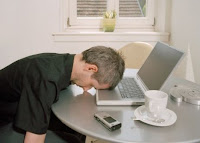
Your resume is one of the most important tools when trying to obtain employment; it's a document that contains all of your educational background, career experience, and skills and achievements. You never want to wait till the last minute when putting a resume together, it should be built over time and change with every career or educational accomplishment you make. The reason you should build overtime is because you may forget about past employers and leave out valuable information that may have slipped your mind at the time. It will also give you time to perfect it, leaving no grammatical or professional errors. Believe it or not, but employers strongly frown upon resumes that have even the slightest grammatical errors, it may even lessen your chance of obtaining that dream job. Cramming a resume together at the last minute can be stressful, but when built over time you will be confident that it will project the exact information that you want it to.
This is what happens when you wait till the last minute to write your resume, you forget valuable names and achievements, and have no idea what your going to do.

This is what happens when your resume is built over time, contains all valuable information, and is as close to perfect as possible. You will be confident in your resume and yourself.

When you are putting your resume together you want to keep it targeted towards the type of employment that you are trying to obtain. You shouldn't just send out a generic resume, but instead research the company your applying to and tailor your resume for that specific company.
You should also keep in mind that there are a few different ways to compose your resume. According to Technical communication in the 21st Century, there are chronological, skills, and entry-level resumes.
- Chronological- You must summarize your experience and training in the order in which it occurred(beginning with the most recent). This type of resume highlights facts, degrees, job titles, and dates(Dorbin).
- Skills- This type of resume emphasizes the experience and skills that qualify the applicant for the position, rather than specific degrees, titles, and dates(Dorbin).
- Entry-Level- These resumes are used when you have little to no related experience in the position you are applying for. This type of resume follows the same format as the other two, but instead of focusing on credentials you should focus on who you are as a person. You should include details that show you are trustworthy, smart, reliable, and interesting(Dorbin).
There are five main sections that should be included in every resume;
- Contact information
- career objective
- education
- experience
- skills and achievements
References:
Dorbin, Sidney I., Christopher J. Keller and Christian R. Weisser. Technical Communication: In the Twenty-First Century. Upper Sadle,NJ: Pearson Prentice Hall, 2008.










 reference:
reference:







 Could cost a candidate his opportunity of the job. Even the smallest error in your resume could suggest to your readers that you are not detail oriented or concerned with quality(pg.409). Even the highest qualified candidates may be eliminated if their resumes or cover letters contain errors. My overall advice when writing a resume would be to assume you cannot afford to make mistakes. Then regardless whether you are the highest qualified, you will have a good shot at landing the job.
Could cost a candidate his opportunity of the job. Even the smallest error in your resume could suggest to your readers that you are not detail oriented or concerned with quality(pg.409). Even the highest qualified candidates may be eliminated if their resumes or cover letters contain errors. My overall advice when writing a resume would be to assume you cannot afford to make mistakes. Then regardless whether you are the highest qualified, you will have a good shot at landing the job.







